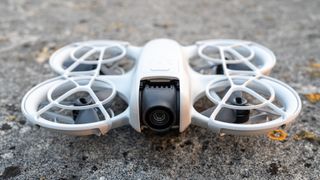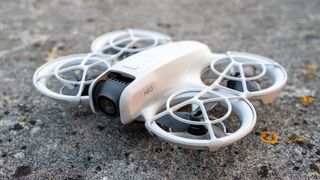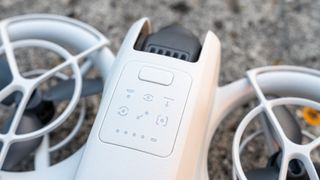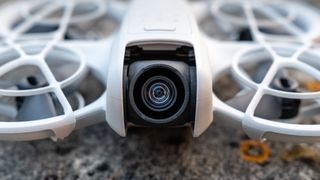DJI Neo: one-minute review
If you’ve heard of the HoverAir X1, you’ll already have some idea of what the DJI’s latest drone, DJI Neo is capable of. But in true DJI fashion, the Neo isn’t simply capable of incredibly easy-to-operate autonomous flight to capture photos and videos, it can also be flown like a camera drone and even used as an FPV drone when paired with DJI’s FPV controllers and goggles.
It’s often said that one size rarely fits all, but the Neo does an impressive job of catering to a wide range of drone pilots from absolute beginners looking for pure simplicity to advanced FPV pilots and everyone in between. It’s an interesting and exciting concept that moves the Neo away from simply being a clone of the HoverAir X1.

It’s still an extremely simple beginner-friendly drone, electronics and algorithms aside, with only downward visual positioning and a single-axis gimbal. Stabilization is provided in-camera unless switched off with Rocksteady or HorizonBalancing modes available. Stabilization is achieved thanks to the 1/2-inch sensor providing plenty of pixels to cover up to 45 degrees of horizontal tilt when capturing video.
Photo and video capture is pretty basic with 4K 30fps being the only UHD option, while FHD can be shot at 30, 50 and 60fps. 12MP photos can only be captured in JPEG format and can be set to 4:3 or 16:9 aspect ratios. This comes as little surprise given the competitive price of the Neo, but with multiple controller and flight options available, a little more functionality in the photo and video department is always welcome.
DJI Neo: release date and price
- Released September 5 2024
- The base kit costs just $199 / £169 / AU$299
- Fly More Bundle costs £299 / AU$539 but not available in the US
The DJI Neo was announced and is available for sale in the DJI Store and other retailers on September 5 2024. Despite the multiple ways the Neo can be controlled, there are two main kits available with the base kit including the drone, battery and accessories costing $199 / £169 / AU$299.
This kit allows for controller-free and app-controlled flight, while the Fly More Bundle includes the drone, a DJI RC-N3 Controller, three Smart Batteries and a Battery Charging Hub. This kit costs £299 / AU$539 but isn’t available in the US, where the DJI Neo Combo is on sale instead for $289 (which doesn’t include the controller).
The Fly More Bundle allows for controller-free, app control and to fly the Neo like a camera drone using the RC-N3 Controller. The Neo can also be paired with the DJI FPV Remote Controller 3 and DJI Goggles 3 for manual FPV flight, or the goggles and the DJI RC Motion 3 for intuitive FPV control.
If you don’t already own these devices, they will drive up the cost of the Neo substantially to the point where the DJI Avata 2 could be the better option if FPV is your thing.

DJI Neo: design and handling
- Micro whoop design
- Enclosed propellers
- Single axis gimbal
To cut a corner or two, the easiest way to describe the Neo is to say it’s a little like a mini DJI Avata 2; it has propeller guards, but with top and bottom guards to protect people during autonomous flight, and the camera sits at the front and moves and stabilizes mechanically on a single axis. Horizontal stabilization is applied electronically in-camera.
DJI Neo key specs
Camera: 12MP 1/2-inch sensor
Video resolution: Up to 4K
Frame rates: 4K 30fps / FHD up to 60fps
Video transmission range: 6.2 miles (FCC), 3.7 miles (CE/SRRC/MIC)
Flight modes: Sport, Normal, Cine (Manual with the FPV Controller 3)
Battery: 1435mAh / up to 18 minutes flight time
Charger type: USB-C / Battery Charging Hub
Weight: 4.76oz / 135g
Dimensions: 5.12×6.18×1.90in / 130×157×48.5mm
In DJI’s signature light grey that’s used for the Mini series of drones, the Neo is incredibly small and lightweight. It’s essentially slightly larger than the palm of your hand, which is ideal for palm take-off and landing, and weighs in at a mere 4.76oz / 135g. This makes it regulator-friendly in most regions since it’s below the all-important 250g threshold, but remember to check local rules if it’s your first drone.
Despite the low weight, the Neo is built to a high quality and feels robust in the hand. The top-mounted propeller guards are removable to allow the propellers to be changed when necessary, but the main propeller guards are part of the airframe. This suggests that home repairs won’t be possible if damage occurs in a crash so if you plan on using the Neo for FPV, taking out DJI Care Refresh would be a good choice.
In true DJI fashion, the Neo is incredibly easy to use and even if you’re unsure of anything, you never really have to poke around in the app too much for what your looking for. Even if you’ve never used a drone, you won’t find it difficult to get up and into the air to capture aerial photos and video.
In terms of access to flight parameters, camera controls and more advanced features and functionality, there’s a sliding scale from the most simplistic app free use of the Neo up to the RC-N3 Controller, with the latter providing the most options and the best overall user experience.
I’ve already listed all of the controller options so I won’t go into detail again, but will instead focus on the DJI Fly app and the RC-N3 Controller, which are part of the standard kits and are likely to be the most commonly used control methods.
The Neo can be flown without an app, using just the mode button on the top to initiate autonomous flight, using the DJI Fly app as a ground station for autonomous flight or using the on-screen controls.
The Fly More bundle include the DJI RC-N3 Controller, which extends the transmission distance from 50m when using the app with the Neo’s WiFi to standard camera drone distances.
These are, of course, governed by the aviation authority where you live. The RC-N3 Controller also makes the Neo behave like a camera drone, with standard controls and features such as Return to Home.
DJI Neo: features and performance
- Unremarkable flight speeds
- Intelligent flight modes
- AI subject tracking
The Neo is pretty pedestrian in terms of flight speed at just 1.11mph in Cine mode, 13.42mph in Normal mode and 17.89mph in Sport mode when flying autonomously or using the RC-N3 Controller. It feels slow but is certainly fast enough to track most subjects, including cyclists, with that top speed.
Flight speed is doubled to 35.79mph when using the DJI FPV Remote Controller 3 in Manual mode, so it does have some grunt tucked up its sleeve if you have the right controller and DJI Goggles 3. Not to mention, the skills and ability to fly in this mode alongside the cash available to purchase the controller and goggles if you don’t already own a set.
For beginners though, these speeds won’t cause any issues and the ability to fly the Neo with or without any other device, through voice control or manually like a camera drone using the DJI Fly app controls or the RC-N3 Controller is ideal. For drone-only use of the Neo, it can take off and land in the palm of your hand once the selected intelligent flight mode has completed, except for Follow mode where you stop and place your hand below the Neo to make it land.

Intelligent flight modes include Follow, Dronie, Circle, Rocket, Spotlight and Custom (Omni, Helix, and Boomerang). AI subject tracking also aims to keep the subject in the centre of the frame during photo and video capture, so if you’re taking a group photo with the Neo, for example, you’d have to make sure you’re standing centre front.
When I tested palm take off without the app, the Neo did everything it was supposed to in terms of flight but for some reason no video was captured. The Neo, despite not having collision avoidance was able to follow me successfully under tree branches and around trees, which was impressive, but the lack of video capture was frustrating. Initiating these flight modes with the app, where you can also change flight parameters, always successfully captured footage.
There’s also voice control which, to be honest, seems completely pointless because you have to have the DJI Fly app open on your smartphone for it to work, once the feature is switched on in the menu. Voice control would ultimately be more beneficial when the Neo is used independently of the app.
The overall design of the Neo has safety in mind, and when used with the RC-N3 Controller you can enjoy GPS, an on-screen map and Return to Home. There’s no collision avoidance, but there are downward vision positioning sensors with a precision range of 0.5-10m. Plus, the Neo offers up to level 4 wind resistance, which is 18mph.
When used with the DJI RC Motion 3 Controller, as well as enjoying intuitive motion controls for FPV flight, you can also take advantage of Easy ACRO where you can Flip, Roll and 180° Drift the Neo. It’s an easy way to enjoy acro flight without advanced manual flight skills and is inherited from the Avata 2 when paired with the Motion 3. This is by far the easiest way to fly FPV flight.
DJI Neo: image and video quality
- 1/2-inch sensor
- Up to 4K 30fps video
- 12MP JPEG photos

The Neo features a 12MP 1/2-inch sensor which allows for 45 degrees of horizontal tilt when using Image Stabilization with either Rocksteady or HorizonBalancing modes. Image Stabilization works incredibly well.
DJI are one of the best in this field, and there are no complaints with the results. One thing to bear in mind is that when flying close to or at the drone’s maximum wind resistance, is that wind movement of the Neo is visible in footage – there’s no getting away from it.
The camera provides a 117.6-degree field of view, with a full-frame equivalent focal length of 13mm, so nice and wide for close-to-subject tracking. Keeping things simple, the aperture is fixed at f/2.8 with fixed focus providing focus from 60cm to infinity.
The ISO range extends from ISO 100 to 6400 in both Manual and Auto shooting modes, with the shutter speed ranging from 1/8000 to 1/10 sec for photos and 1/8000 to 1/30 sec for video.
Photo and video functionality is pretty basic, but you get everything you need at a consumer level with 4K video locked at 30fps with a bitrate of 75Mbps, so it’s reasonably compressed but not too much.
The 4K video from the Neo looks good, if not slightly oversharpened. So, if you’re using the RC-N3 Controller where you get many more options for the drone and camera in the DJI Fly app, dialling down the sharpening would be beneficial. For the testing, sharpening was left at the default to show what you get out of the box, particularly for pilots who will only use palm and app-controlled flight.
The color profile is Standard for straight-out-of-camera footage, with no flat profile available for color grading within a professional workflow. Looking at the design of the Neo and the camera, it doesn’t look like it would support ND filters to control shutter speed, but I could be wrong.
Photos can only be captured in JPEG format, which is a shame but no big deal since this is a drone that’s best suited to video capture. JPEG processing is, however, heavy even at lower ISO levels, although colors do remain faithful Photos and videos captured with the Neo, like most drones, look best in sunny conditions.
JPEGs can be captured in 4:3 and 16:9 aspect ratios, with Single and Timed Shot available, so once again basic but adequate for a beginner drone. The electronic stabilisation also appears to handle the drone’s roll (tilt to the side) well, but in stronger winds with the camera pointed downwards at an angle, uneven horizons do become more of an issue.
There’s no microSD card slot on the Neo, but you do get 22GB of on-board storage which DJI says equates to 40 minutes of 4K 30fps video or 55 minutes of 1080p 60fps video. This can be transferred to the the DJI Fly App when connected to the Neo’s WiFi using Quick Transfer, or downloaded to your computer when the Neo is connected via the included USB-C PD cable.
Intelligent flight modes video
App and controller video
DJI Neo: testing scorecard
| Attributes | Notes | Rating |
|---|---|---|
| Price | Reasonably priced, especially for beginners | 5/5 |
| Design | FPV-style design and well made | 4/5 |
| Performance | Multiple control options but flight is slow | 4/5 |
| Image and video quality | Video is better than photos, but settings are limited | 3.5/5 |
Should I buy the DJI Neo?
Buy it if…
Don’t buy it if…
DJI Neo: also consider
The HoverAir X1 is another tiny drone that takes flight from the palm of your hand and boasts intelligent subject tracking and flight modes. However, the X1 is pricier than the Neo, it only shoots 2.7K video and it doesn’t offer the wide ranging ways to control it that the Neo does. There are X1 successors though, the X1 Pro and X1 Pro Max, that look like firmer competition.
Read our in-depth HoverAir X1 review
How I tested the DJI Neo
- All features and functions tested
- Flown with the DJI RC-N3 Controller
- DJI Fly app options checked
The Neo was tested in a range of conditions including overcast, bright and sunny and windy to see how it performed in these situations.
All features and functions, including photo and video capture, were also tested to assess their effectiveness in real world situations, often in demanding situations to truly test the Neo’s capabilities.
With several control options available with the drone, I tested voice control, palm take off without the use of the DJI Fly app, app control and use of the DJI RC-N3 Controller. DJI FPV accessories weren’t included with the review sample, so the Neo’s FPV capabilities couldn’t be tested.
First reviewed September 2024














